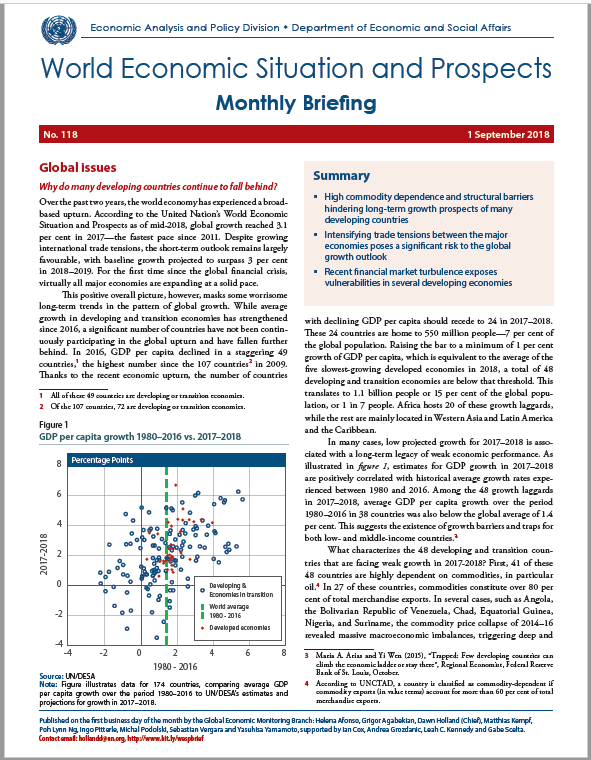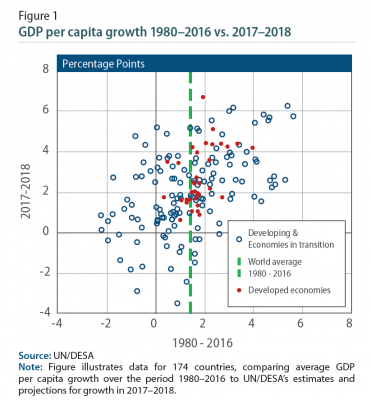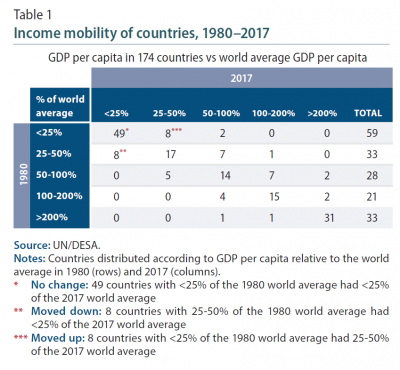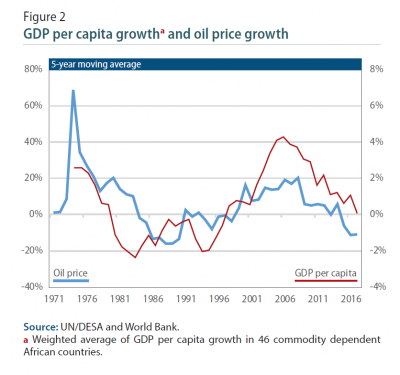
World Economic Situation And Prospects: September 2018 Briefing, No. 118
- High commodity dependence and structural barriers hindering long-term growth prospects of many developing countries
- Intensifying trade tensions between the major economies poses a significant risk to the global
growth outlook - Recent financial market turbulence exposes vulnerabilities in several developing economies
English: PDF (176 kb)
Global issues
Why do many developing countries continue to fall behind?
Over the past two years, the world economy has experienced a broad-based upturn. According to the United Nation’s World Economic Situation and Prospects as of mid-2018, global growth reached 3.1 per cent in 2017—the fastest pace since 2011. Despite growing international trade tensions, the short-term outlook remains largely favourable, with baseline growth projected to surpass 3 per cent in 2018–2019. For the first time since the global financial crisis, virtually all major economies are expanding at a solid pace.
This positive overall picture, however, masks some worrisome long-term trends in the pattern of global growth. While average growth in developing and transition economies has strengthened since 2016, a significant number of countries have not been continuously participating in the global upturn and have fallen further behind. In 2016, GDP per capita declined in a staggering 49 countries, the highest number since the 107 countries in 2009. Thanks to the recent economic upturn, the number of countries with declining GDP per capita should recede to 24 in 2017–2018. These 24 countries are home to 550 million people—7 per cent of the global population. Raising the bar to a minimum of 1 per cent growth of GDP per capita, which is equivalent to the average of the five slowest-growing developed economies in 2018, a total of 48 developing and transition economies are below that threshold. This translates to 1.1 billion people or 15 per cent of the global population, or 1 in 7 people. Africa hosts 20 of these growth laggards, while the rest are mainly located in Western Asia and Latin America and the Caribbean.
 In many cases, low projected growth for 2017–2018 is associated with a long-term legacy of weak economic performance. As illustrated in figure 1, estimates for GDP growth in 2017–2018 are positively correlated with historical average growth rates experienced between 1980 and 2016. Among the 48 growth laggards in 2017–2018, average GDP per capita growth over the period 1980–2016 in 38 countries was also below the global average of 1.4 per cent. This suggests the existence of growth barriers and traps for both low- and middle-income countries.
In many cases, low projected growth for 2017–2018 is associated with a long-term legacy of weak economic performance. As illustrated in figure 1, estimates for GDP growth in 2017–2018 are positively correlated with historical average growth rates experienced between 1980 and 2016. Among the 48 growth laggards in 2017–2018, average GDP per capita growth over the period 1980–2016 in 38 countries was also below the global average of 1.4 per cent. This suggests the existence of growth barriers and traps for both low- and middle-income countries.
What characterizes the 48 developing and transition countries that are facing weak growth in 2017-2018? First, 41 of these 48 countries are highly dependent on commodities, in particular oil. In 27 of these countries, commodities constitute over 80 per cent of total merchandise exports. In several cases, such as Angola, the Bolivarian Republic of Venezuela, Chad, Equatorial Guinea, Nigeria, and Suriname, the commodity price collapse of 2014–16 revealed massive macroeconomic imbalances, triggering deep and prolonged crises. These economies are either still in recession or on a painfully slow recovery path.
Second, 17 of the 48 countries are classified as least developed countries (LDCs). This underscores the hurdles faced by countries with a very low development base and limited resources for crucial investment in areas such as infrastructure, healthcare and social programmes. As a result, low incomes often tend to be “sticky”. The mobility matrix (Table 1) shows the distribution of countries by GDP per capita relative to the world average in 1980 and 2017. Out of the 59 countries with a level of GDP per capita in 1980 of less than 25 per cent of the global average (row 1), 49 remained in the same category in 2017 (no change), whereas 8 reached 25–50 percent of the average, and two—China and Thailand—had progressed dramatically, to attain a level of GDP per capita of more than 50 per cent of the world average. By contrast, out of 33 countries with a level of GDP per capita in 1980 between 25 and 50 per cent of the world average (row 2), 8 countries saw their relative GDP per capita deteriorate below the 25 per cent threshold by 2017. The degree of stickiness during this period was even more pronounced for the highest income category (more than twice the world average GDP per capita), while mobility was much greater for the middle-income categories.
Third, a significant number of growth laggards are mired in long-standing armed conflicts (Afghanistan, Somalia, Yemen), or face civil unrest and instability (Burundi, Bolivarian Republic of Venezuela, Democratic Republic of the Congo). While geographical barriers and exposure to weather-related shocks act as a restraint on growth prospects in many cases, the experience of individual countries varies significantly. Among the 32 landlocked developing countries (LLDCs), only 7 are among the 48 countries identified as growth laggards above. However, all the commodity-dependent LLDCs recorded a sharp decline in GDP per capita growth following the collapse in global commodity prices in 2014–2015. Meanwhile, among the 34 small island developing States (SIDS), only 11 are among the 48 growth laggards.
While there is no single factor that explains why some countries continue to fall further behind, dependence on commodities—which generally implies a lack of developed non-commodity sectors in the economy—appears to be a common denominator among this heterogenous group. The experiences of China and several other East and South Asian economies, which managed to achieve high and relatively stable growth in GDP per capita over the past four decades, suggests that there are no ultimate traps to development. Nonetheless, the well-known barriers to growth remain the same in 2018 as they were in the past—conflict and a lack of economic diversification. The prospect of rising global temperatures over the coming decades can be expected to exacerbate another long-standing barrier to growth—a hostile climate.
Developed economies
United States: Imports stagnate amid rising trade tensions
Amid the build-up of trade tensions, the Unites States has abandoned or renegotiated a number of bilateral and plurilateral trade agreements, and over the course of 2018 has announced and introduced a wide range of tariff hikes, creating considerable uncertainty in the global trade arena. To date, the impact of this uncertainty on business investment has been offset by the major fiscal stimulus measures introduced in 2018, including a 2 percentage points drop in income tax rates, a steep decline in the corporate tax rate and rise in Federal government consumption spending, especially on defence. The economy of the United States is operating at or close to full capacity and exhibited robust annualized growth of 4.1 per cent in the second quarter of 2018. Net trade made a strong positive contribution to GDP growth in the second quarter of the year, as export growth remained steady while import volumes stagnated. Imports of services, especially travel services, dropped sharply. Weak import volumes limit scope for positive spillovers from the buoyant United States economy on the rest of the world.
Europe: Solid growth with significant downside risks
The growth outlook for Europe remains robust, but downside risks are high. Strong private consumption growth is underpinned by dynamic labour market conditions and rising disposable income. Business investment and construction activity will also be supported by the European Central Bank’s (ECB) loose monetary policy stance. However, downside risks to the region’s outlook have increased. Amid rising trade tensions among major economies, various product groups have become the subject of new or changed tariff regimes. A tightening of trade restrictions poses a significant risk for the export-reliant European economies. As the United Kingdom of Great Britain and Northern Ireland prepares to leave the European Union (EU), the transition phase will entail significant uncertainty, particularly over future trade relations between the two parties. This increases the risk of businesses diverting investments away from the United Kingdom. The ECB faces the challenge of designing and communicating a normalization of its monetary policy stance, both in terms of its asset holdings and the policy rate, which could become an additional source of financial market volatility.
Most of the East European members of the EU maintained robust growth in the first half of 2018, albeit with some slowdown in the Czech Republic. Many countries registered record low unemployment and accelerating wage growth, in part explained by persistent labour shortages. Concerns about overheating, along with currency pressures linked to the stronger dollar and the announced tapering of the ECB’s ultra-loose stance, have prompted a few central banks to tighten monetary policy.
Economies in transition
Commonwealth of Independent States (CIS): Potential sanctions have sparked currency volatility
Most of the CIS economies recorded favourable GDP growth in the first two quarters of 2018, as the recovery in the Russian Federation supported economic activity across the region. However, in early August, the United States announced plans to tighten economic sanctions against the Russian Federation, with the possibility of targeting several large banks and Russian sovereign debt, adversely impacting the Russian rouble and stock market. While the central bank’s downscaling of foreign exchange purchases in accordance with the budget rule should curb currency volatility, the weakening of the rouble has had spillover effects on several CIS currencies, in particular Kazakhstan.
The Russian economy expanded by 1.3 per cent and 1.8 per cent in the first two quarters, as the FIFA 2018 World Cup provided a large boost to the tourism industry. In Kazakhstan, the economy expanded by over 4 per cent in the first half of 2018, reflecting rising oil and gas output and investment in transport infrastructure, while disinflation facilitated private consumption.
Among the energy-importers, Belarus, benefiting from improved Russian demand and a strong expansion of industrial exports to non-CIS countries, registered GDP growth of 4.5 per cent in the first half of 2018, while a stronger currency facilitated disinflation. In Ukraine, GDP expanded by over 3.5 per cent over the same period. However, growth prospects have been hampered by mass emigration, which is also driving up wage costs. The country is facing tough policy choices following IMF loan delays, as large external debt repayments are due in 2018–2019; monetary policy was tightened in 2018 to defend the currency. In Central Asia, growth exceeded 7 per cent in Tajikistan in the first half of 2018, supported by rising aluminium and gold output, remittances, and Chinese investment into metal processing. A sudden downturn in commodity prices, banking sector weaknesses, geopolitical conflicts and tighter external funding conditions remain the main risks for the region.
Developing economies
Africa: High commodity dependence weighing on medium-term growth prospects
The recent global economic upturn has created a conducive environment for policymakers in developing countries to undertake necessary structural reform measures. Nevertheless, progress on economic diversification across most African economies has remained very slow. According to UNCTAD, 46 African countries remain classified as commodity dependent, leaving the well-being of its citizens vulnerable to the vagaries of global commodity prices. Figure 2 illustrates the strong positive relationship between oil price movements and GDP per capita growth in commodity-dependent Africa over the past four decades.
 Out of the 48 economies identified in the Global Issue section as registering weak GDP per capita growth in 2017–2018, 20 are in Africa. All are highly sensitive to commodity prices, with 18 of the 20 countries exhibiting a share of commodities in merchandise exports of almost 90 per cent. While South Africa and eSwatini are not formally classified as commodity dependent, commodities account for about 50 per cent and 40 per cent of total exports, respectively. Moreover, commodity dependence increased in 26 African countries between 2009–10 and 2014–15, with an average rise in the commodity share of exports of 13 percentage points.
Out of the 48 economies identified in the Global Issue section as registering weak GDP per capita growth in 2017–2018, 20 are in Africa. All are highly sensitive to commodity prices, with 18 of the 20 countries exhibiting a share of commodities in merchandise exports of almost 90 per cent. While South Africa and eSwatini are not formally classified as commodity dependent, commodities account for about 50 per cent and 40 per cent of total exports, respectively. Moreover, commodity dependence increased in 26 African countries between 2009–10 and 2014–15, with an average rise in the commodity share of exports of 13 percentage points.
East Asia: Escalating trade tensions clouding the region’s growth outlook
The region’s robust GDP growth performance extended into the second quarter of 2018, underpinned by resilient domestic demand and positive export growth. In China, GDP growth remained solid, supported by robust consumer spending and supportive fiscal policies. The growth momentum, however, moderated slightly to 6.7 per cent, as the continued slowdown in the industrial sector more than offset stronger services growth. In addition, ongoing policy measures to curb credit growth dampened investment activity, as local governments cut back on infrastructure spending. Looking ahead, the Chinese authorities face a difficult policy challenge of containing financial vulnerabilities while supporting growth.
For most other economies in the region, growth has been relatively sustained. In the Republic of Korea and Taiwan Province of China, exports continued to benefit from strong global demand for semiconductors and consumer electronics. Thailand’s investment prospects have been lifted by the recent launch of the Eastern Economic Corridor, which aims to develop the eastern provinces into a manufacturing and services hub.
Leading indicators, including Manufacturing Purchasing Managers’ Indices and export orders, point towards a growth moderation in most economies in the second half of the year. In addition, downside risks to the region’s growth outlook have increased, arising from heightened global financial market volatility and intensifying trade tensions between the United States and China. A further escalation of trade barriers will significantly affect the East Asian economies, given the region’s high trade openness and deep integration into global production networks. Persistent uncertainty surrounding the imposition of tariffs will also weigh on the region’s investment outlook.
South Asia: Economic outlook largely positive, but some countries face significant turbulence
The economic outlook for the South Asian region remains favourable, driven largely by India, which accounts for more than 70 per cent of regional GDP. The Indian economy is expected to continue expanding at a rapid pace of above 7.0 per cent in 2018 and 2019, amid vigorous private consumption, the recovery of gross fixed investment, and benefits from previous reforms. Public investment in infrastructure will remain a priority, while monetary policy is gradually tightening. However, some economies in the region are also facing increasing economic and financial difficulties. The economic outlook in the Islamic Republic of Iran is rapidly deteriorating, due to domestic weaknesses and the re-imposition of sanctions by the United States. The sanctions are expected to weaken the currency, exacerbate goods shortages and constrain productive capacity and export revenues. In addition, structural limitations, such as the prolonged period with restricted technology transfer, banking fragilities and financing restrictions, will continue to limit economic growth. Meanwhile, the economy of Pakistan is expanding at a fast pace, supported by large infrastructure initiatives under the China-Pakistan Economic Corridor. However, Pakistan is facing significant financial vulnerabilities, amid large twin fiscal and current account deficits, a visible decline in international reserves, and mounting currency pressures. Public debt is high, at close to 70 per cent of GDP, and the Government may seek assistance from the IMF, for the second time in the last five years. To promote more sustainable medium-term growth, policymakers in Pakistan must strike a balance between encouraging much-needed infrastructure investments to alleviate the chronic energy shortages and addressing large external imbalances.
Western Asia: Sharp depreciation of Turkish lira casts a shadow of uncertainty
Following a few months of gradual depreciation, the Turkish lira plunged in August. Nonetheless, the immediate impact on the real economy has been limited, as the central bank has managed to maintain liquidity in both domestic and foreign currencies. However, the situation remains challenging to ensure a soft landing of the Turkish economy.
The financial turmoil in Turkey casts a shadow of uncertainty over the economies in the region. This compounds stagnant values for financial and property assets. This is dampening the economic recovery of the member States of the Gulf Cooperation Council (GCC), namely Bahrain, Kuwait, Oman, Qatar, Saudi Arabia and the United Arab Emirates, despite higher oil revenue. Weak property markets are also negatively impacting domestic demand in Jordan and Lebanon, where the Governments also face challenges in implementing fiscal reform measures to raise revenues. Meanwhile, growth in Israel remains robust, but the weakening property market poses a downside risk. In Iraq and Syria, more signs of economic stabilization are being observed. However, the political and security situation remains fragile in both countries, hampering reconstruction efforts. The crisis in Yemen remains dire amid deteriorating food security and balance of payments conditions.
Latin America and the Caribbean: Weaker growth prospects in large economies weigh on regional outlook
The economic recovery in Latin America and the Caribbean lost momentum in the first half of 2018, amid renewed weakness in some of the region’s large economies, notably Argentina and Brazil. Moreover, downside risks to the regional outlook have increased, amid rising global trade and geopolitical tensions and tighter financing conditions.
In Brazil, the growth outlook has weakened, reflecting the impact of a 10-day nationwide truckers’ strike in May, lower business confidence, continuing political uncertainty, and a more challenging external environment. Argentina’s short-term economic prospects have deteriorated even more sharply in recent months. Following a currency crisis in the second quarter, Argentina’s Government and the IMF agreed in June to a Stand-By Arrangement amounting to 50 billion dollars. The associated economic adjustment plan entails tighter monetary and fiscal policy, which will hamper GDP growth in 2018 and 2019. Also weighing on the regional outlook are the socio-economic crises in the Bolivarian Republic of Venezuela and Nicaragua, while Mexico’s growth prospects have slightly weakened in recent months, amid monetary policy tightening, downward pressure on the peso and uncertainty related to trade tensions and NAFTA negotiations.
Conversely, in Chile, Colombia and Peru, GDP growth has picked up thanks to strong consumer spending and recovering investment. The short-term outlook for these economies remains largely favourable, but prospects are sensitive to external demand from China, in particular, and global financial conditions.
Meanwhile, in the Caribbean, Suriname and Trinidad and Tobago are finally recovering from prolonged recessions, which were triggered by the commodity price shock of 2014–2015. Short-term prospects for the subregion, however, remain constrained by fiscal adjustment programmes in several countries, as the region is plagued by high levels of public debt. Barbados, where the public debt-to-GDP ratio is among the highest in the world, requested balance of payments assistance from the IMF in June.

Follow Us